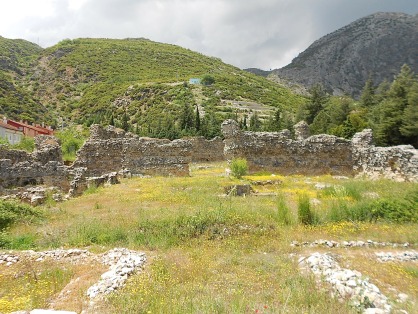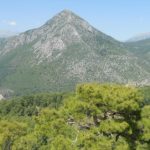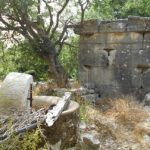On the eastern flank of Eğirdir in the Turkish Lake District there stands a caravanserai in such an abject state of ruination that it’s hard even to recognise that it was once one of the links in the chain of places to stay that kept the great caravan trains of the Selçuks going. A sign at the site realates a sad story: the building of the han in 1237 followed by its demise sixty-four years later in a great conflagration, sparked, who knows, by a carelessly disregarded fire lit to keep the cold of the Anatolian winter at bay.
There it might have ended with the ruins slumbering undisturbed until the 2000s when suddenly the restorers would have descended with a vengeance. But in this particular instance what actually happened was that the local lord, one Dundar Bey, decided that what had been so lovingly built should not be allowed to go entirely to waste and so had the grand portal of the caravanserai moved three kilometres westwards to become the entrance to his new medrese in what is now the centre of Eğirdir.
Peering through the utterly pointless fence protecting the ruins from interested passers-by, I was struck by the urge to backtrack towards Beyşehir and take a look at the Ertoküs Kervansarayı, whose central dome I’d glimpsed peeping up above the orchards of the tiny lakeside village of Yeşilköy.
The dolmuş driver was of a dozy disposition. Asked to drop me at the caravanserai he instead tried to leave me in front of a teahouse called Hanönü (In Front of the Han). This mix-up once sorted out, I found myself strolling down a rather attractive cobbled street that led past a farmhouse whose elderly owners stared at me as they might have stared at a newly resurrected Selçuk warrior passing by. No matter. The sun was out. The poppies were in bright Sisley bloom. All was right with my world.
Until I reached the caravanserai that is. Because here I found myself confronted with the exact opposite of the situation in Eğirdir. Here, three years had been spent not so much on restoring the building as crudely rebuilding it, then slapping in front of it the usual dreary detritus of modernity that provides some sort of justifying cover for the money wasted (ahem, spent). Steps down to the door had been laid. Low walls had been placed to provide a framework. Ornamental carriage lights had been erected at the corners. A ticket office had been installed. Then, their work complete, the “restorers” had slapped a padlock on the gates and walked away since when the weeds had run riot through their landscaping.
In the rush to restore every historic building in the country over the last ten years, caravanserais, along with castles, have been some of the main losers. Most mosques have been pleasingly restored, as have many old Ottoman houses. But when it comes to caravanserais and castles a complete aesthetic blindness seems to descend. Whether it’s from a desire to get the job done as quickly/cheaply as possible or because these monuments are in remote locations where few people ever get to see what is being done to them the story is the same countrywide. Bayburt Castle. Tercan Kervansarayı. El-Aman Hanı. All so completely rebuilt as to obliterate all signs of their long histories. I could go on were it not such a depressing story.
It took me less than five minutes to walk around the caravanserai and ascertain that no interesting old stonework had been left in place. A sign informed me that the caravanserai had been commissioned by Mübarezettin Ertokuş in 1223. It also told me that there was an inscription over an internal gateway. How to see it though when the gate was locked?
Keeping the caravanserai company were two houses on which, arguably, the restoration money might have been much better spent. One was completely and obviously derelict. The other? I wasn’t quite sure. It looked battered enough to be abandoned, yet there hovered about it something that suggested it might just still be occupied. I walked round to the side and peered into a shed beneath the stairs. The nervous faces of two cows stared back at me, which did, at least, confirm continued residency.
Warily, I mounted the steps to the first floor where the open door made it plain that not only was the house still occupied but that its owners were as house-proud when it came to interiors as any other Turks. An elderly woman on crutches hobbled into view. I was just stuttering my apologies for disturbing her when a younger woman with barely any teeth left appeared.
“I was wondering if you might have the key to the han?” I asked hopefully.
She shrugged her head, that emphatic, telling Turkish gesture of negation. “Three years they worked here. Then they went away and didn’t leave the key. Lots of people come here like you. They drive down. They ask me for the key but I can’t help them.”
“What a waste of money then,” I snorted and she grimaced in agreement.
Perhaps surprisingly there followed no offer of çay, and I hurried away again, feeling an intruder. Back at the farmhouse the elderly owners were still sitting on their front step. “E-egh?” grunted the woman.
“It’s locked,” I replied.
“Huh,” she agreed, and that was that.
Now here’s my question for the powers-that-be. What is the point of spending money on rebuilding ancient monuments for which there is no alternative use and not enough visitors to justify the cost of a warden? Lovers of history such as myself would be much happier with the old stones left to whisper to our imaginations in a way that tamed, weed-strewn renewals never can. What makes this example so particularly irritating is that had the same money been invested in the Eğirdir ruin – which, without its portal, is beyond any claims to romantic beauty – then a new use could quite possibly have been found for it. As a wedding venue, for example, or as a setting for the sort of Turkish nights that pull in the punters so lucratively elsewhere.
Written: 30 May 2013


